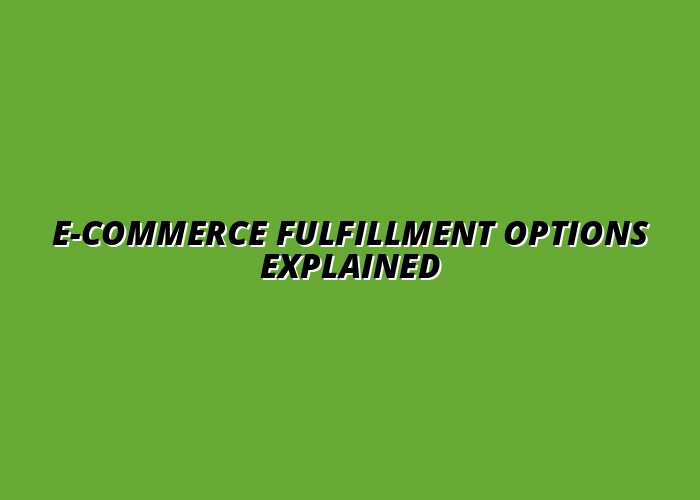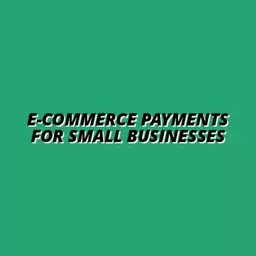E-Commerce Fulfillment Options Explained

Posted on: 2025-09-07
By: Liam Corbin
What if your business's success hinged on a single process that could enhance customer satisfaction and loyalty? In the dynamic world of e-commerce, fulfillment is that crucial element. A streamlined fulfillment process not only ensures timely deliveries but can significantly boost your brand's reputation and profitability. Let's delve into the key insights that will empower you to optimize your e-commerce fulfillment strategy.
What You Will Learn
- Understanding e-commerce fulfillment is essential for enhancing customer satisfaction and driving repeat business.
- Selecting the right fulfillment method—be it in-house, third-party logistics, or dropshipping—can transform your operational efficiency.
- Adopting sustainable fulfillment practices, such as eco-friendly packaging, can improve your brand image and attract environmentally conscious consumers.
- Integrating AI and automation into your fulfillment process can lead to faster order processing and a superior customer experience.
- Meeting rising consumer expectations for same-day delivery requires innovative last-mile solutions and strategic partnerships.
- Effective returns management, including clear policies and easy processes, is pivotal for maintaining customer relationships and enhancing satisfaction.
- Evaluating your fulfillment strategy based on geographic reach, customer expectations, and your business model is key to long-term success.
Key E-Commerce Fulfillment Options Comparison
The following outlines the primary e-commerce fulfillment methods, highlighting their unique benefits and challenges. For an in-depth look at managing your inventory efficiently, explore our guide on efficient e-commerce inventory management tips.
In-House Fulfillment
Full control over inventory and shipping, but may lead to higher operational costs.
Third-Party Logistics (3PL)
Outsourcing to specialized providers can save time and resources.
Fulfillment by Amazon (FBA)
Leverages Amazon's logistics network for efficient shipping.
Dropshipping
Sell without holding inventory, but may have less control over fulfillment.
Understanding E-Commerce Fulfillment: Key Concepts and Importance
When diving into the world of e-commerce, one of the most critical aspects to grasp is fulfillment. But what exactly is e-commerce fulfillment? It refers to the entire process of receiving, processing, and delivering orders to customers. Think of it as the backbone of your online business—it ensures that products reach your customers quickly and efficiently. A smooth fulfillment process can be the difference between a satisfied customer and a lost sale.
Understanding this concept is vital for any business owner. Proper fulfillment not only enhances customer satisfaction but also boosts your brand’s reputation. When customers receive their orders on time, they’re more likely to return for future purchases. This leads to increased loyalty and, ultimately, higher profits! So, let’s explore how e-commerce fulfillment plays a significant role in your business success.
Defining E-Commerce Fulfillment and Its Role in Business Success
In simple terms, e-commerce fulfillment is all about getting products from your shelves into your customers' hands. This involves several steps: order processing, picking, packing, and shipping. Each of these stages must be executed flawlessly to ensure a positive customer experience. At The Cash Automator, we understand that the smoother this process is, the more likely you’ll see success in your online ventures!
Moreover, e-commerce fulfillment can directly impact your business metrics, such as customer retention rates and order accuracy. A well-defined fulfillment strategy can lead to quicker delivery times and lower shipping costs, which are essential in today’s fast-paced market. When customers feel valued through timely deliveries, they are more inclined to spread the word about your business. You can also explore how to automate your e-commerce sales efficiently to further streamline your operations.
Importance of Choosing the Right Fulfillment Option for Retailers
Choosing the right fulfillment option can be a game-changer for your e-commerce business. There are various methods, each with its unique benefits and challenges. The key is to align your fulfillment strategy with your business goals. For instance, consider these options:
- In-House Fulfillment: Managing your inventory and shipping.
- Third-Party Logistics (3PL): Outsourcing to specialized providers.
- Fulfillment by Amazon (FBA): Leveraging Amazon's vast logistics network.
- Dropshipping: Selling without holding inventory.
Each option has its own set of pros and cons. For instance, while in-house fulfillment gives you full control, it can also lead to higher operational costs. On the other hand, using a 3PL provider can save you time and resources, allowing you to focus on scaling your business! The right choice ultimately depends on your unique business needs and customer expectations.
Quick Summary
Here's a brief recap of the key points discussed so far:
- Understanding Fulfillment: It's the backbone of your e-commerce business, ensuring timely delivery and customer satisfaction.
- Choosing the Right Option: In-house, 3PL, FBA, and dropshipping each have unique benefits that can align with your business goals.
- Future Innovations: Sustainability and automation are reshaping fulfillment practices, making them more efficient and environmentally friendly.
Future Trends and Innovations in E-Commerce Fulfillment
The world of e-commerce is constantly changing, and so is the way we fulfill orders. As I dive into these trends, it’s clear that staying ahead can really make a difference for your business. One of the most exciting areas is the focus on sustainability in fulfillment practices. More companies are looking to reduce their environmental impact, and this is reshaping how fulfillment operates.
Picture this: businesses are now opting for eco-friendly packaging and more efficient shipping methods. This not only appeals to customers but also aligns with the growing demand for sustainable practices. As e-commerce continues to grow, the idea of being green will become a major selling point!
Emerging Trends: Sustainability in Fulfillment Practices
Many retailers are incorporating sustainability into their fulfillment strategies. Here are a few common practices:
- Using biodegradable packaging materials
- Implementing carbon offset programs
- Optimizing delivery routes to reduce emissions
- Partnering with environmentally conscious shipping carriers
By adopting these practices, companies not only contribute to a healthier planet but also enhance their brand image. Customers are increasingly favoring brands that prioritize sustainability, which can lead to increased loyalty and sales.
AI and Automation: The Future of Order Fulfillment
As someone who believes in leveraging technology for better outcomes, I’m thrilled about the advancements in AI and automation within the fulfillment process. These technologies can streamline operations, making order processing faster and more accurate. Imagine a system that can predict stock needs or automatically update inventory levels—this is the future!
Here are some benefits of integrating AI and automation into fulfillment:
- Reduced manual errors in order processing
- Faster order processing times
- Improved customer experience through accurate tracking
- Enhanced data analysis for better decision-making
With platforms like The Cash Automator, you can learn how to implement these technologies effectively. They can help you stay competitive in the evolving market. For more insights on how to leverage technology, consider exploring automated systems for wealth growth.
Same-Day Delivery and Last-Mile Solutions: Meeting Consumer Expectations
Have you noticed that consumers want their orders faster than ever? Same-day delivery is quickly becoming a standard expectation. As a business owner, it’s crucial to adapt to this trend to keep your customers happy.
Here are some strategies to consider for improving last-mile delivery:
- Partnering with local courier services for quicker deliveries
- Implementing a pickup point system for customer convenience
- Utilizing technology to optimize delivery routes
- Offering incentives for customers who choose slower shipping options
By focusing on these solutions, you can not only meet but exceed customer expectations, which is essential for building trust and loyalty.
Making Informed Decisions: Choosing the Best Fulfillment Option
As you explore your options for order fulfillment, there are several key factors to consider. Choosing the right service can significantly impact your business’s efficiency and customer satisfaction. Understanding your specific needs will help you make the best decision.
Factors to Consider When Selecting a Fulfillment Service
When assessing different fulfillment services, here are some important factors:
- Your geographic reach and target market
- Customer expectations regarding shipping times
- Your budget and cost considerations
- The size and scale of your inventory
By carefully evaluating these aspects, you’ll be better equipped to choose a fulfillment model that aligns with your business goals. Remember, this decision can greatly influence your overall success!
Geographic Reach and Market Demand
It’s essential to consider where your customers are located. A fulfillment center that’s too far away may lead to longer shipping times, which can frustrate your customers. Aim for a service that can reach your target audience efficiently!
Assessing Your Business Model and Customer Expectations
Your business model will play a crucial role in selecting the right fulfillment option. For instance, if you’re focusing on high-volume sales, you may prioritize speed and efficiency over cost. Alternatively, smaller businesses might benefit from lower costs even if delivery is a bit slower.
Returns Management: Handling Returns Effectively
Let’s face it—returns are a part of e-commerce. How you manage them can make or break your customer relationships. Efficient returns processing is key to maintaining customer satisfaction.
Strategies for Efficient Returns Processing
Here are some strategies I’ve found effective for managing returns:
- Clearly outlining return policies on your website
- Providing prepaid return labels for easy returns
- Implementing a simple returns portal for customers
- Analyzing return data to identify trends and improve products
By streamlining your returns process, you not only improve customer experience but also learn valuable insights about your products. For more tips on retaining customers, read about boosting e-commerce customer loyalty.
Frequently Asked Questions About E-Commerce Fulfillment
- What is e-commerce fulfillment?
E-commerce fulfillment refers to the entire process of receiving, processing, and delivering orders to customers, serving as the backbone of online businesses by ensuring quick and efficient product delivery. - What are the main e-commerce fulfillment options?
The main options include in-house fulfillment (managing inventory and shipping yourself), Third-Party Logistics (3PL) (outsourcing to specialized providers), Fulfillment by Amazon (FBA) (leveraging Amazon's network), and dropshipping (selling without holding inventory). - How does sustainable fulfillment benefit a business?
Sustainable fulfillment practices, such as using biodegradable packaging and optimizing delivery routes, contribute to a healthier planet, enhance brand image, and attract environmentally conscious customers, leading to increased loyalty and sales. - What role do AI and automation play in e-commerce fulfillment?
AI and automation streamline operations by reducing manual errors, speeding up order processing, improving tracking, and enhancing data analysis, making fulfillment faster, more accurate, and competitive. - Why is same-day delivery important for e-commerce businesses?
Same-day delivery is becoming a standard consumer expectation. Adapting to this trend through strategies like local courier partnerships and optimized routes helps businesses meet and exceed customer expectations, building trust and loyalty. - How can effective returns management improve customer relationships?
Efficient returns management, achieved through clear policies, prepaid labels, and simple returns portals, not only improves customer experience but also provides valuable insights into product trends, helping maintain customer satisfaction and loyalty.
Conclusion and Next Steps: Evaluating Your Fulfillment Strategy
As you evaluate your fulfillment strategy, remember that it’s all about finding what works best for you and your customers. Take the time to analyze your options and think about how they align with your business model.
Encouraging Retailers to Analyze Their Options
Don’t hesitate to reach out for guidance! Explore the various fulfillment options available and consider how they can enhance your business. Each choice has its unique benefits and challenges, so assess them carefully.
Inviting Feedback and Questions for Further Engagement
If you have questions or thoughts about fulfillment strategies, please feel free to share! Engaging with our community at The Cash Automator is a great way to learn and grow together. To further optimize your online presence, consider learning about SEO strategies for e-commerce success.
Recap of Key Points
Here is a quick recap of the important points discussed in the article:
- Understanding E-Commerce Fulfillment: The entire process of receiving, processing, and delivering orders is crucial for customer satisfaction and business success.
- Choosing the Right Fulfillment Option: Options include in-house fulfillment, third-party logistics (3PL), Fulfillment by Amazon (FBA), and dropshipping—each with distinct benefits and challenges.
- Sustainability Trends: Adopting eco-friendly practices like biodegradable packaging and optimized delivery routes can enhance brand image and customer loyalty.
- AI and Automation: These technologies streamline order processing, improve accuracy, and enhance customer experience, making them essential for modern fulfillment.
- Same-Day Delivery Expectations: Strategies such as partnering with local couriers and offering pickup points can help meet the growing demand for faster deliveries.
- Returns Management: Efficient handling of returns through clear policies and a streamlined process can significantly improve customer retention.
- Evaluating Your Fulfillment Strategy: Analyzing your specific needs and customer expectations is key to selecting the best fulfillment model for your business.
 Creating a membership site can be your gateway to generating income effortlessly, allowing you to ea
Creating a membership site can be your gateway to generating income effortlessly, allowing you to ea
 As the e-commerce landscape evolves, small businesses must adapt to stay competitive. Did you know t
As the e-commerce landscape evolves, small businesses must adapt to stay competitive. Did you know t
 When it comes to affiliate marketing, leveraging the power of webinars can transform your approach.
When it comes to affiliate marketing, leveraging the power of webinars can transform your approach.